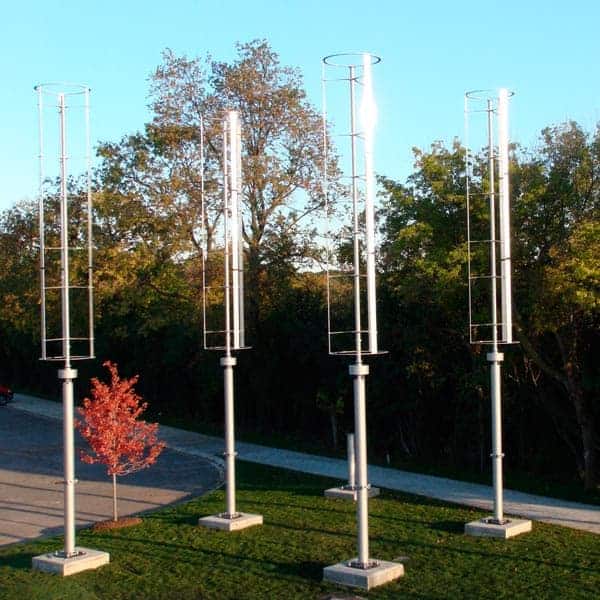
Conventional wind turbines work best when located as far as possible from the destructive vortices of neighbouring turbines. However, a pair of scientists in the US have worked out that the performance of other kinds of turbine actually improves when they are placed close to one another, concluding that wind farms could therefore be made much smaller than they are today.
The familiar propeller-like turbine with a horizontal axis of rotation can convert 50% or more of the energy from the wind that it is exposed to. In a wind farm, however, the wake from one turbine will disturb the air reaching the blades of its neighbours meaning that turbines must be placed far apart. Typically, to ensure that it generates about 90% of the power that it would in isolation, a turbine must be placed about three rotor diameters from its nearest lateral neighbours and around 10 rotor diameters from the turbine downstream. For a rotor with a diameter of 100 m this latter figure becomes 1 km – a considerable distance.
A less familiar family of turbines have a vertical axis of rotation. It includes a number of different sub-types, including those that use drag to push the device around and others that use aerofoils to generate lift. Individually, these vertical-axis turbines are less efficient than the horizontal-axis devices because only part of the turbine can be pushed by the wind at any one time, and they have therefore proven far less popular. However, these turbines have a significant advantage over the horizontal-axis variety – their power output can be increased when they are placed very close to one another.
How fish save on energy
Now, Robert Whittlesey and John Dabiri of the California Institute of Technology have worked out how best to arrange such closely spaced turbines by drawing on the work of aeronautical engineer Daniel Weihs, who showed in the 1970s how fish save on energy by swimming within schools. Such fish form a series of offset rows, and Weihs found that fish get carried forward by the vortices created by the swimming motion of their two closest companions in the row immediately in front of them. Whittlesey and Dabiri wondered whether the relative spacing of vortices produced by an individual fish might serve as a good template for the arrangement of vertical-axis turbines within a wind farm and set up a computer model to test this idea.
The researchers took wind speed and other measurements from a vertical-axis turbine and then fed these data into the model, in which they analysed various arrangements of virtual turbines to see if any of these would lead to greater average rotation than that that of a free-standing turbine. What they found was that a staggered column of alternately clockwise- and anticlockwise-rotating turbines significantly enhances the speed of turbine rotation. The reason, they say, is that the presence of neighbouring turbines concentrates and accelerates the wind.
More power per unit area
Whittlesey and Dabiri found that vertical-axis turbines arranged in this way could produce a power per unit area 100 times that of existing, horizontal-axis wind farms. Whittlesey points out that this would make wind power more attractive in those countries where there is plenty of wind but limited space such as islands like the UK or Japan, and would also lower infrastructure costs related to connecting up of the turbines, although it is not clear whether the overall cost will be cheaper given the greater number of individual turbines that would be required.
The team have yet to test their theory by measuring the power from different arrangements of actual turbines in a field. He says that they intend to carry out such measurements in the near future.
This research is being presented at the annual meeting of the American Physical Society’s Division of Fluid Dynamics, which is being held in Minneapolis on 22–24 November.



